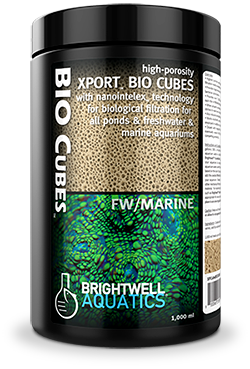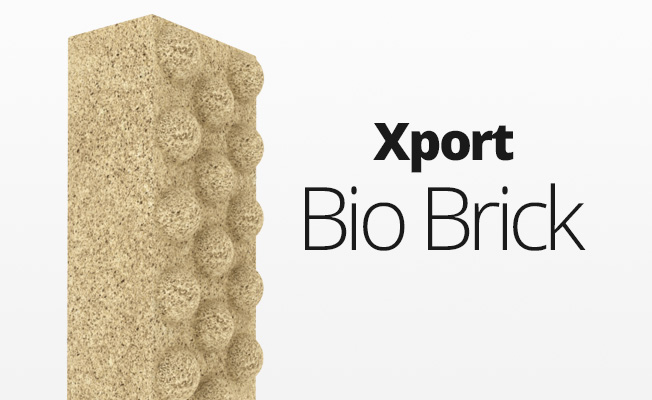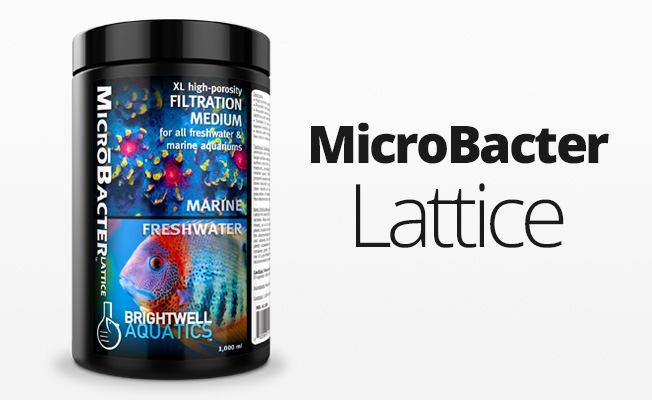
Xport BIO Cubes
Ultra-porous Biological Media with Superior Performance Characteristics
Overview
- Designed to be used in marine and hard freshwater aquariums with a pH of 7.5 or over
- Utilizes NanoIntelex Technology to create an enhanced material with vast surface area for colonization by beneficial nitrifying bacteria, resulting in rapid and efficient conversion of ammonia into nitrite and nitrate.
- Providing over 71,000 square feet per liter, it provides the highest colonizable surface area to volume ratio of synthetic or natural biological filtration media available anywhere in the world.
- Higher efficiency relative to conventional media results in smaller space requirements to achieve equivalent nitrification.
- May be employed to rapidly decrease ammonia and nitrite concentrations in even the most heavily-stocked aquatic systems.
- May be used in conjunction with Xport NO3 Cubes and Xport PO4 Cubes
Sizes
250ml | 500ml | 1,000ml | 2L | 4L | 20L
Instructions Guidelines
Read all instructions before use. Use about 2 to 4 XPort Bio Cubes for every 10 U.S. gallons ( 38 L ) of system capacity, more for heavy bio loads. Rinse material well with aquarium water or purified tap water to remove any dust. For superior results, seed the material using only the specific bacteria product that you are using in the aquarium. If using MicrōBacter Start XLM, use one capful to seed (add balance of bacteria directly to the aquarium). If using FlorinBacter7, MicrōBacter7 or MicrōBacterCLEAN add full recommended dose. Place XPort Bio Cubes in a plastic container, filling it with aquarium water, and then adding the bacterial product, based on the size of your aquarium, to that container. Allow to stand overnight and then add the seeded XPort Bio Cubes to your system. Discard the soak water. It is recommended that you use sponge, fine filter floss or other mechanical filtration ahead of XPort Bio Cubes to prevent clogging with organic material. For maximum results, also provide a good carbon source for growing bacteria, such as Brightwell® Katalyst bio pellets or liquid Reef BioFuel or FlorinAxis as appropriate for your aquarium, as directed on their label. For maximum nitrification, place in an area of good flow with good oxygenation.
Recommendation: Do not use different bacteria products in an aquarium, particularly during startup! When an aquarium is new, the available nutrients for bacteria to consume are scarce and if the kind of bacteria you introduce requires organics, they will likely not be available and the two different bacterial cultures can fight each other. It is best to start out with MicrōBacter Start and cycle the tank, and then progress to MicrōBacterCLEAN at cycling completion. Then progress to MicrōBacter7 or FlorinBacter7at 4 to 6 months of age. This will provide the cleanest and fastest route to meet your goals and provide a beautiful and sustainable bacterial ecosystem. Particularly do not introduce foreign strains of bacteria such as "live sand", pre-cultured dry man made "live rock," etc. It is ok to use rocks from other aquariums that have already cycled and live rock purchased from stores. All forms of man made or natural live rock (except dry pre-cultured), aragonite and marco rock will work fine. If you introduce the wrong strains of bacteria, at the wrong time, you can slow down the whole process.
Important: Do not fluidize or allow to rub against other filtration material which could cause grinding down.
Xport Bio Cubes is not a chemical filtration media; it must be seeded with appropriate bacteria to begin nitrification. Simply placing Xport Bio Cubes into an established aquarium will slowly seed the media, however seeding with MicroBacter7 as directed above will significantly decrease cycling time and therefore results in faster colonization. If plants and/or zooxanthellate invertebrates (e.g. corals, clams, etc.) appear to react negatively to the use of Xport Bio Cubes, it may be an indication that nitrogen is being removed too aggressively; NeoNitro or FlorinGro may be employed to provide nitrogen as nitrate, and feeding with the appropriate foods is necessary for all zooxanthellate invertebrates. Note that the required amount of Xport Bio Cubes may change as the system matures, and as biomass and/or stocking density changes; high-nutrient systems may require a greater ratio of Xport Bio Cubes to water volume, evident as a persistent ammonia presence regardless of how much MicroBacter7 is employed.
This product will work for nitrification, the conversion of ammonia to nitrate and also for denitration, the conversion of nitrate to nitrogen gas. For maximum nitrification, it is best to provide maximum oxygen to the material, so mount it in air, if possible and trickle water over it. If you must submerge it, provide very good flow (but do not fluidize!). For maximum denitration, create an anoxic zone (a zone of very low oxygen) for the cubes by severely limiting water flow through the chamber that you place them in. If you don't have a suitable anoxic zone, then place the cubes in a plastic jar with a plastic lid. Drill two small holes in the lid on the top to allow the nitrogen gas bubbles that will form to escape and two small holes near the bottom of the jar on the vertical surface of the side. All holes should be 3/16" or 5 mm in diameter. Place the jar in an area of mild to low flow. This will significantly increase the amount of NO3 that the Xport can remove.
Caution: Keep out of reach of children. Not for human use or consumption.


